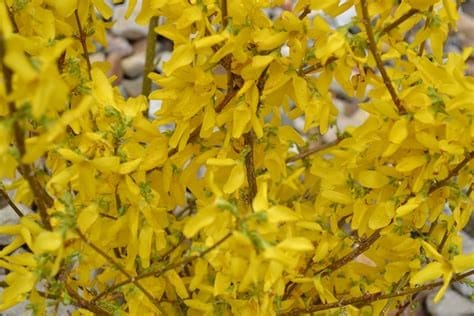Forsythia bushes (Forsythia suspensa, F. spp.) not only offer a pretty burst of color in early spring, the flowers are also edible and can be used in many food and DIY beauty & body care recipes.
In THIS STUDY in the Frontiers in Pharmacology Journal I learned that “Forsythia sp. fruit preparations are traditionally used to treat infectious and inflammatory diseases, especially in Chinese medicine, and the in vitro and in vivo activities of such preparations have been proven scientifically… However, in temperate climates… fruits are not produced. The only viable sources of forsythia active compounds are the flowers and leaves.”
Of current interest for spring 2020 – forsythia is part of an anti-viral formula being studied in China. (Also see Stephen Buhner’s herbal protocol.)
More interesting sources/studies to read:
- The Mechanism of Phillyrin from the Leaves of Forsythia suspensa for Improving Insulin Resistance
- Anti-inflammatory and Antimicrobial Effects of Heat-Clearing Chinese Herbs: A Current Review
This early spring flower is associated with the sun, thanks to its yellow flowers, and it seems to have an uncanny ability to blossom without any care or tending whatsoever–it’s not uncommon to find random forsythia plants in full bloom at properties long since abandoned.
According to some legends, once the forsythia flowers begin to bloom, it means you’ll still have three more snowfalls before the winter is truly over.
During the Victorian era, flowers were assigned special meanings, as part of a “secret language of flowers.” The forsythia is associated with anticipation. Use forsythia in workings related to things you hope to see happen in the long-term. Also consider using it in divination workings–after all, knowing things in advance leads to anticipation!
Forsythia is a hardy plant that blooms with little to no maintenance–try using it in magical workings related to longevity and sustainability of your goals.
If you do any work with numerology, forsythia is associated with the number four. This in turn is connected to the four elements–earth, air, fire, and water–as well as the cardinal directions and the four seasons. Four is sometimes connected to creativity. In Chakra energy work, the heart is the fourth chakra, and so it relates to emotions and our compassion towards others.
Laurie Cabot, in her book Love Magic, recommends clipping a few forsythia stalks and placing them in a jar of water on your altar to bring love your way–as the buds begin to open up and flower, so will your love life. There’s a Korean legend that tells the story of man returning to his wife after a long journey, and finding her waiting by a forsythia bush. He was struck by her beauty, and vowed to never take their love for granted again.
Fun and creative things to make with forsythia flowers:
Forsythia Infused Oil
Make up a jar of this oil to have on hand for lotions, creams, soaps, body butters, lip balm, and lotion bars.
To make: Collect fresh forsythia flowers and spread them in a single layer on clean dish towels or paper towels. Allow to air dry for a few days. Fill a jar half-way with dried flowers, pour oil into the jar until it’s almost filled, then stir a few times to release air bubbles. Suggested oil types include olive (for soapmaking) or sunflower, grapeseed, sweet almond, apricot kernel, or rice bran for lotions, creams, and lotion bars.
For a quick infusion, heat the jar of oil uncovered on low for 2 to 3 hours in a small saucepan containing a few inches of water. For a slow infusion, cover with a lid and infuse at room temperature in a cabinet for 4 to 6 weeks before straining and using.
Forsythia Flower Lotion
This lightweight lotion is especially suitable for those with oily and acne-prone skin, but can be used as a non-greasy moisturizer for all skin types. You’ll need an accurate scale (I use THIS ONE) to make this recipe.
- 17 g forsythia infused grapeseed (or your favorite) oil (see #1 above)
- 5.5 g emulsifying wax (Mountain Rose Herbs or Amazon)
- 50 g distilled water
- 25 g witch hazel
- preservative of choice*
- optional – 1 to 2 drops of tea tree or lavender essential oil
Directions to make forsythia flower lotion:
- Weigh the distilled water and witch hazel in a heatproof container.
- Weigh the infused oil and vegetable emulsifying wax in a separate heatproof container. (I use two small 4 oz jelly/canning jars.)
- Place both jars down into a saucepan containing a couple inches of water, forming a double boiler of sorts.
- Turn the burner to medium low and heat until the wax is fully melted – about 10 to 15 minutes.
- Pour the hot water/witch hazel and melted wax/oil together into a clean jar and stir briskly with a fork for several minutes.
- Stir frequently. The lotion will thicken as it cools. I often place the container down into a bowl of ice water to help speed this step up.
- Once cool enough for your preservative of choice, stir that in and mix well.
- Add essential oil if you’d like. Tea tree is especially helpful for acne prone skin, while lavender is nice for all skin types.
- Pour into lotion containers or jars. Jar shown is a 4 oz canning jar.
Forsythia Jelly
For a tasty addition to your pantry, try forsythia jelly which tastes a bit like honey. (Yum!)
Ingredients
- 1 cup forsythia flowers
- 1 1/4 cups water
- 1 3/4 cups sugar
- 1 oz Suregel low sugar pectin (pink box)
Recipe
Pick your forsythia flowers, making sure as you go that you haven’t left the little green caps at the base on- they pop off easily enough with a gentle tug- and shaking off any bugs that might be hitching a ride as you go.
Rinse the flowers lightly after you’ve collected your cup, and set the clean flowers aside. In a small pot, bring the water to a boil, and pour overtop the flowers, leaving to steep for 2 hours to overnight, depending on your personal preference.
Once finished steeping, strain out the plant matter from the tea, and discard, either in the trash or in the compost heap. The tea is ready to use.
Pre-measure out your sugar, and set aside. Add the pectin directly to the tea, stirring it in- it won’t all dissolve, but try to break up big lumps. Pour the pectin-tea mix into a medium or medium-large pot, and place it on a burner turned to high heat.
Bring to a hard boil, stirring constantly, and boil for one minute. Dump in the sugar all at once, and stir to dissolve completely, bringing the jelly back to a boil. Boil again for another minute, and immediately remove from heat. Pour the hot jelly into warm jars, lid, and leave completely alone to sit undisturbed for 24 hours or overnight.
Store finished jelly in the refrigerator, and use within 2 weeks. This recipe should not be canned, as there is not enough acidity in the jelly to be safe.
Forsythia Clear Skin Toner
This toner is great for skin that tends towards redness and breakouts. To use, dampen a fresh cotton ball with the toner and swipe over your face after washing.
- 1/2 cup loosely packed fresh forsythia flowers (or half as many dried)
- 1/2 cup simmering hot water
- 1/4 cup witch hazel
- 1/4 tsp vegetable glycerin
Pour the hot water over the forsythia flowers and steep for 10 to 20 minutes or until the water has turned a light yellow color. Strain. Mix 1/4 cup of forsythia/water infusion with the witch hazel and glycerin. Stir well and pour into a small glass bottle or jar. Store in your fridge for 5 to 7 days.


